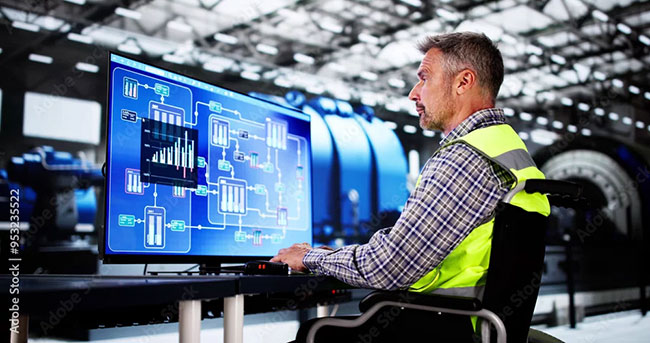
Features
Ask the Expert: Avoid these remote monitoring mistakes
March 24, 2025 By Dave DeFusco, Sensaphone
 There are many common errors to watch out for when using remote monitoring technologies for a RAS facility.
photo: Andrey Popov / Adobe Stock
There are many common errors to watch out for when using remote monitoring technologies for a RAS facility.
photo: Andrey Popov / Adobe Stock Remote monitoring technology optimizes RAS management and condition tracking, eliminating the need for 24/7 on-site staffing. By continuously monitoring equipment and environmental parameters, this technology helps detect and address potential issues before they become hazardous to aquatic life.
With real-time alerts, operators can quickly respond to changes, preventing small issues from escalating into larger problems. Advanced remote monitoring systems use cloud technology, enabling operators to access live status updates via apps or web interfaces. This immediate visibility lets personnel take swift action when the system detects anomalies.
When implementing 24/7 remote monitoring devices and sensors in recirculating aquaculture systems (RAS), there are several common misconceptions that can reduce system effectiveness and compromise fish health.
Understanding these pitfalls can help operators optimize their systems, ensure accurate monitoring and prevent costly errors. Let’s examine the advantages of incorporating a remote monitoring system as well as a few of the most prevalent issues that can thwart these benefits and how to avoid them.
Core components
Remote monitoring systems are built around a central base unit that continuously gathers data from strategically installed sensors on RAS equipment.
Each tracked condition requires a designated sensor input on the base unit. Advanced systems are designed to integrate seamlessly with equipment managed by programmable logic controllers (PLC) or building automation systems (BAS).
Operators can connect to monitoring systems through internet or wifi connections, or by using units equipped with cellular modems that transmit data via cellular networks. Many manufacturers manage cellular service internally, eliminating concerns about SIM cards or overage charges. The only requirement is a stable cellular signal at the facility.
Cloud-based remote monitoring provides real-time access to system data from any location by using remote servers for large-scale data storage. Remote monitoring providers prioritize data security by using private cloud networks, restricting public access and continuously overseeing the system to ensure its stability. To guarantee uninterrupted service, multiple backup servers are distributed across different locations.
In RAS, sensors play a critical role in tracking key water quality parameters that operators must maintain to promote the health and growth of the fish. Additionally, sensors provide insights into the system’s overall performance, helping to identify inefficiencies and potential equipment malfunctions.
Primary conditions to track include water temperature, oxidation-reduction potential, pH levels, dissolved oxygen, toroidal conductivity, ammonia, nitrites, nitrates, vibration, pressure, power failure, and water flow, level and leaks.
Common errors
Assuming Sensors are Maintenance Free
Many believe that once installed, sensors will continue to provide accurate data indefinitely. However, most sensors, especially those measuring parameters like pH, dissolved oxygen and ammonia, require regular calibration and maintenance. Neglecting to check sensors regularly can lead to inaccurate readings. To avoid this problem, develop a maintenance schedule that includes sensor cleaning, recalibration and inspection.
Relying on One Sensor Per Parameter
Using just a single sensor for each condition that you want to monitor is not sufficient to ensure system reliability. One point of failure can lead to system-wide issues if a sensor malfunctions.
Redundancy is crucial for parameters critical to fish health, such as dissolved oxygen and water temperature. Using duplicate or backup sensors for critical metrics helps you to cross-check data and ensure accuracy.
Placing Sensors in the Wrong Spots
Poor sensor placement within the tank or RAS will not provide representative water quality data. For instance, placing a dissolved oxygen sensor near an aeration outlet might give a false reading, or installing pH sensors in high-flow areas can cause damage to the sensors. That’s why it is important to position sensors strategically where water is well mixed.
Neglecting to Set Appropriate Alarm Thresholds
Setting generic alarm thresholds based on system manufacturer recommendations is not sufficient for monitoring your unique RAS application. Each RAS and species has unique requirements. Using inappropriate thresholds can lead to untimely notifications, unnecessary alarms or delayed responses. Tailor alarm settings based on species-specific needs and historical data trends, and regularly review and adjust thresholds as conditions change.
Not Considering Sensor Drift
Sensor readings do not remain accurate over time. In fact, sensor drift is common, especially for pH, ammonia and nitrate sensors, and can cause a gradual deviation from true values. Therefore, it is important to implement regular calibration protocols and monitor for sudden data shifts that may indicate sensor drift.
Assuming the System is Fully Automated
Although today’s advanced monitoring systems reduce the need for manual intervention, they don’t completely manage themselves. They still require active oversight, periodic system checks and updates to maintain functionality.
It is recommended that you test your monitoring system weekly to be sure it is functioning properly. Conducting weekly tests ensures that the system will promptly notify the appropriate personnel when an issue occurs, and that the team will be familiar with and ready respond to the alert.
The system can be tested by creating a false alarm on each sensor and allowing the system to run through its alarm process. It’s also a good idea to test the battery backup by unplugging the power to make sure the device continues to function.
Ignoring Data Analysis and Trend Monitoring
Obviously, real-time alerts are important, but historical data is equally relevant. Long-term data trends can reveal underlying issues – such as slow nitrate accumulation, biofilter performance degradation, pump malfunction and unusual power fluctuations – that real-time monitoring might miss. Regularly review historical data, perform trend analysis and integrate your findings into maintenance schedules and operational adjustments as needed.
Not Providing Sufficient Power and Connectivity Backups
Don’t assume that your power supply and internet connection are always stable. Power outages or loss of connectivity can leave the RAS unmonitored, putting fish health at risk. Use an uninterruptible power supply (UPS), backup generators and redundant communication methods, like internet and a cellular connection, to maintain monitoring during disruptions.
Failing to Respond to Alerts
An automated alarm doesn’t always prompt an immediate corrective action. Without predefined response protocols, staff may not know how to respond to alarms, leading to delays or incorrect actions. To avoid this mishap, develop standard operating procedures for each type of alert, including who is notified, the immediate actions to take and follow-up steps.
Believing All Sensor Data is Equally Reliable
Sensors are not created equal, therefore keep in mind brand, price and data reliability. Sensor quality varies widely, and the low-cost variety may not perform well in harsh aquatic environments or may be more prone to drift and damage. Invest in robust, proven sensors from reliable vendors for critical parameters, and periodically verify readings against manual tests to confirm accuracy.
Overlooking Environmental Interference
Environmental factors like biofouling, temperature fluctuations and water chemistry changes impact sensor performance. These factors can alter sensor readings or cause physical damage to the sensor. Use sensors that can hold up to harsh environments and inspect them regularly.
Focusing Solely on Water Quality Metrics
Water quality parameters are not the only important metrics in RAS monitoring. Other factors, such as fish behavior, biofilter health and system pressure, can be just as critical to system performance. Implement a holistic monitoring strategy that includes behavioral monitoring, biofilter efficiency tracking and system infrastructure health.
Not Training Staff
Automated remote monitoring systems do not eliminate the need for trained staff. Even the most advanced monitoring systems require knowledgeable personnel to interpret data, maintain equipment and respond effectively to issues. Provide regular training on using the monitoring system, understanding data and acting on alerts.
Avoiding these common misconceptions and addressing these potential mishaps can significantly improve the effectiveness of remote monitoring in RAS, leading to better system stability, healthier fish and optimized operations.
 Dave DeFusco is vice-president of engineering at Sensaphone, a developer and manufacturer of remote monitoring and alerting systems. Reach him at ddefusco@sensaphone.com or 1-877-373-2700.
Dave DeFusco is vice-president of engineering at Sensaphone, a developer and manufacturer of remote monitoring and alerting systems. Reach him at ddefusco@sensaphone.com or 1-877-373-2700.
Print this page